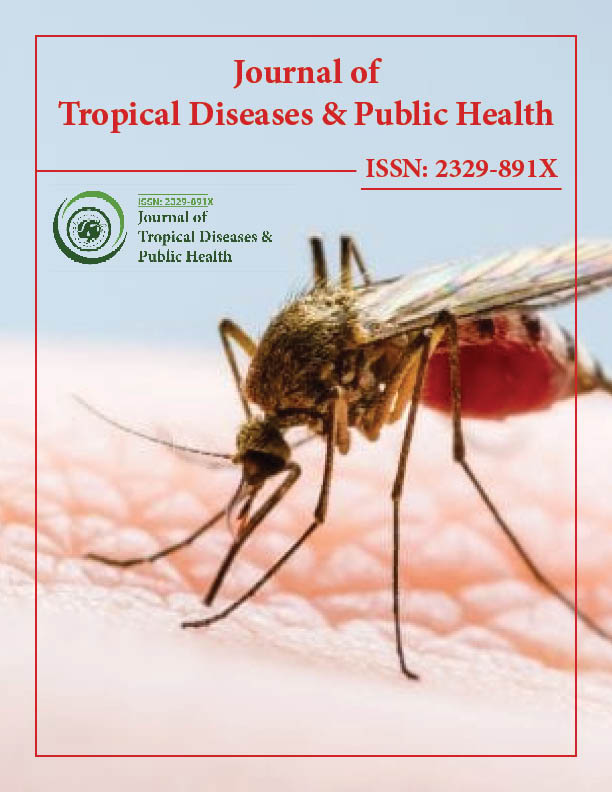Indexed In
- Open J Gate
- Academic Keys
- ResearchBible
- China National Knowledge Infrastructure (CNKI)
- Centre for Agriculture and Biosciences International (CABI)
- RefSeek
- Hamdard University
- EBSCO A-Z
- OCLC- WorldCat
- CABI full text
- Publons
- Geneva Foundation for Medical Education and Research
- Google Scholar
Useful Links
Share This Page
Journal Flyer

Open Access Journals
- Agri and Aquaculture
- Biochemistry
- Bioinformatics & Systems Biology
- Business & Management
- Chemistry
- Clinical Sciences
- Engineering
- Food & Nutrition
- General Science
- Genetics & Molecular Biology
- Immunology & Microbiology
- Medical Sciences
- Neuroscience & Psychology
- Nursing & Health Care
- Pharmaceutical Sciences
Commentary - (2023) Volume 11, Issue 5
Overview of the Different Types of Malaria Endemicity
Cheng Geain*Received: 05-Apr-2023, Manuscript No. JTD-23-20740; Editor assigned: 07-Apr-2023, Pre QC No. JTD-23-20740 (PQ); Reviewed: 21-Apr-2023, QC No. JTD-23-20740; Revised: 05-Jun-2023, Manuscript No. JTD-23-20740 (R); Published: 12-Jun-2023, DOI: 10.35248/2329-891X.23.11.406
Description
Malaria is a mosquito-borne infectious disease caused by the parasite Plasmodium. It affects over 200 million people globally, causing an estimated 435,000 deaths every year. In many places, malaria is endemic, meaning it is constantly present in the population. In these areas, the disease is a major cause of death and disability, and can have a significant impact on socioeconomic development. Malaria is an acute disease, meaning symptoms typically develop rapidly and last for a few days or weeks. The most common symptoms include fever, chills, headache, and nausea.
Malaria is a protozoan disease that is transmitted through the bite of an infected Anopheles mosquito. There are four species of Plasmodium parasites that cause malaria in humans: Plasmodium falciparum, Plasmodium vivax, Plasmodium ovale, and Plasmodium malariae. Malaria is endemic in many areas of the world, with varying levels of endemicity. Endemicity is the prevalence of a disease in a particular population or geographical area. Malaria endemicity can be classified into three categories, hyperendemic, mesoendemic, and hypoendemic. Hyperendemicity is characterized by a high prevalence of malaria and high levels of parasitaemia. This type of endemicity is seen in areas of the world where malaria is transmitted year-round, such as sub- Saharan Africa. Mesoendemic, mesoendemicity is characterized by a moderate prevalence of malaria and moderate levels of parasitaemia. This type of endemicity is seen in areas of the world where malaria is transmitted seasonally, such as parts of central and South America. Hypoendemic, hypoendemicity is characterized by a low prevalence of malaria and low levels of parasitaemia. This type of endemicity is seen in areas of the world where malaria is not usually transmitted, such as North America. It is important to understand the different levels of malaria endemicity in order to investigate the impact of the disease on parasitaemia patterns. Knowing the type of malaria endemicity in an area can help researchers design more effective strategies for controlling malaria transmission.
Factors that influence parasitaemia patterns malaria is a serious global health burden that continues to affect millions of people around the world. Although much progress has been made in understanding the epidemiology and control of malaria, there is still much to learn about the impact of endemicity on parasitaemia patterns. It is well established that the transmission intensity of malaria is determined by a variety of factors, such as climate, population density, vector density, and vector resistance to insecticides. In addition, the prevalence of malaria in a given population is affected by the level of immunity to the disease, which is influenced by the level of endemicity in the region. The level of endemicity is determined by a combination of factors, including the vector density, the vector's resistance to insecticides, and the level of immunity to the disease. The vector density and vector resistance to insecticides can be affected by environmental factors, such as climate, humidity, and rainfall. In addition, the level of immunity to the disease is affected by the level of exposure to malaria in the region. The effects of these factors on parasitaemia patterns vary from region to region. In regions with high endemicity, there is an increased likelihood of higher levels of parasitaemia, as well as an increased risk of severe disease. Conversely, in regions with low endemicity, there is a decreased risk of severe disease, and a decreased likelihood of higher levels of parasitaemia. The impact of endemicity on parasitaemia patterns is an important area of research, as it can help inform public health interventions and strategies for controlling malaria. Understanding the factors that influence parasitaemia patterns can help to identify areas where interventions may be most effective, and can help to inform the design of effective interventions.
Citation: Geain C (2023) Overview of the Different Types of Malaria Endemicity. J Trop Dis. 11:406.
Copyright: © 2023 Geain C. This is an open access article distributed under the terms of the Creative Commons Attribution License, which permits unrestricted use, distribution, and reproduction in any medium, provided the original author and source are credited.

